Business and the Business Environment Report for Tesco PLC: Analysis
VerifiedAdded on 2021/01/02
|15
|3828
|472
Report
AI Summary
This report provides a comprehensive analysis of Tesco PLC within the context of the business environment. It begins with an introduction to the concept of a business and its environment, emphasizing both internal and external factors. The report then explores various organizational types, including public, private (with Tesco PLC as a case study), and voluntary organizations, detailing their purposes, legal structures, advantages, and disadvantages. The second part of the report delves into the size and scope of Tesco PLC, the National Health Service (NHS), and Oxfam, highlighting their visions and missions. The report further examines the interrelation between organizational functions, such as HR, finance, marketing, and IT departments, and how these functions contribute to achieving organizational goals. This analysis includes an organizational chart and discusses how each department supports overall objectives. Finally, the report emphasizes the need for coordination between departments to meet shared objectives and concludes with an overview of how different departments within Tesco PLC interact to achieve company goals.
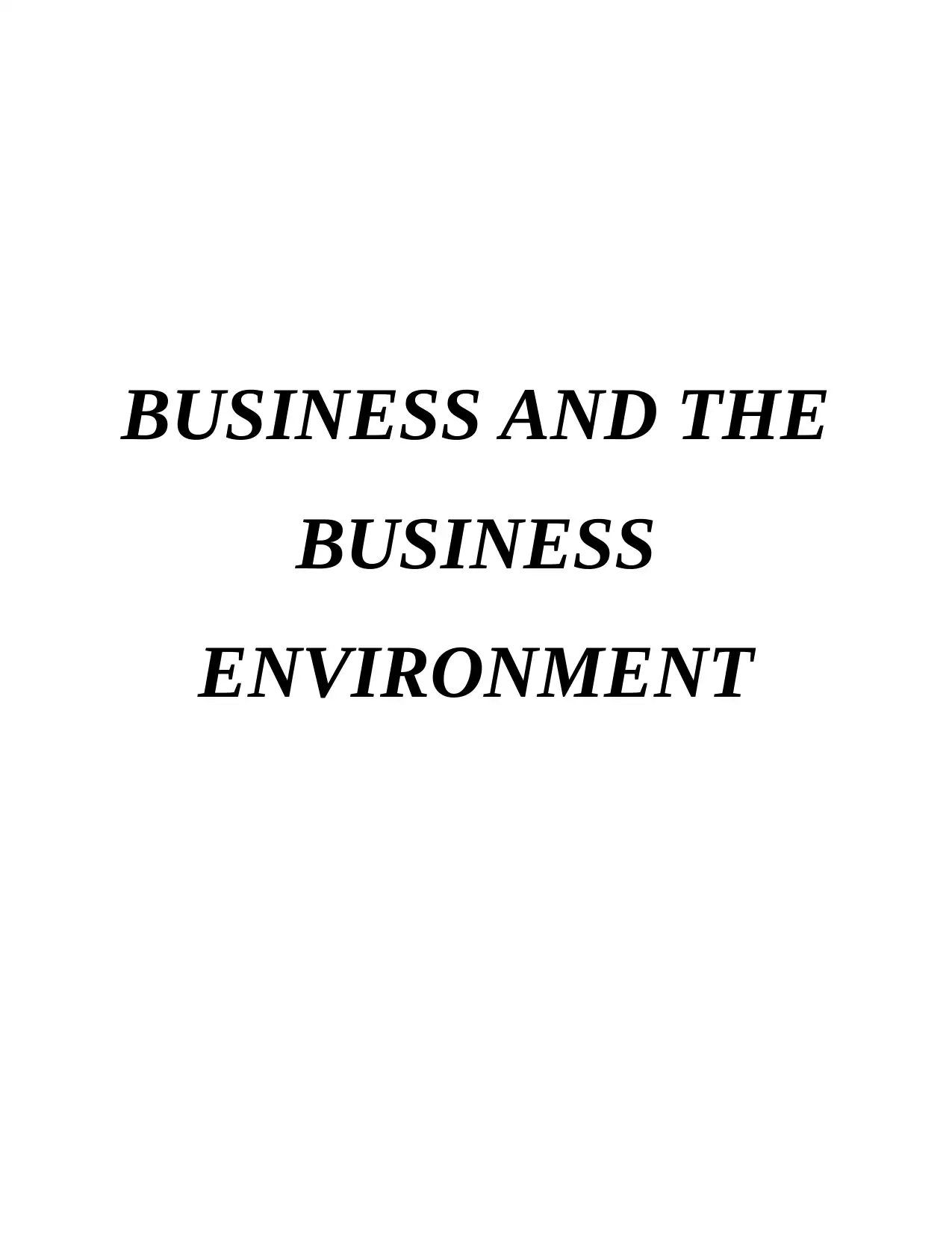
BUSINESS AND THE
BUSINESS
ENVIRONMENT
BUSINESS
ENVIRONMENT
Paraphrase This Document
Need a fresh take? Get an instant paraphrase of this document with our AI Paraphraser

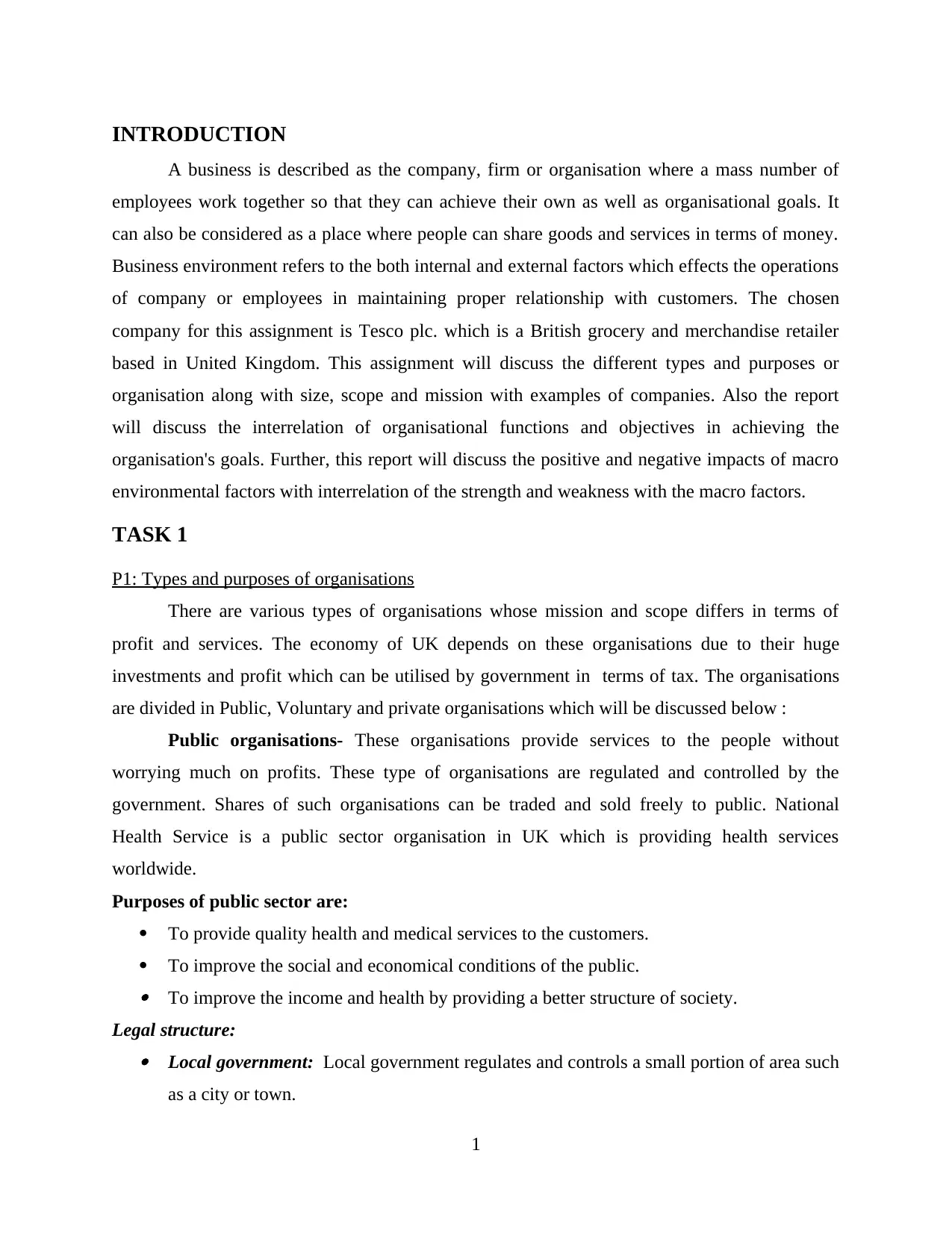
INTRODUCTION
A business is described as the company, firm or organisation where a mass number of
employees work together so that they can achieve their own as well as organisational goals. It
can also be considered as a place where people can share goods and services in terms of money.
Business environment refers to the both internal and external factors which effects the operations
of company or employees in maintaining proper relationship with customers. The chosen
company for this assignment is Tesco plc. which is a British grocery and merchandise retailer
based in United Kingdom. This assignment will discuss the different types and purposes or
organisation along with size, scope and mission with examples of companies. Also the report
will discuss the interrelation of organisational functions and objectives in achieving the
organisation's goals. Further, this report will discuss the positive and negative impacts of macro
environmental factors with interrelation of the strength and weakness with the macro factors.
TASK 1
P1: Types and purposes of organisations
There are various types of organisations whose mission and scope differs in terms of
profit and services. The economy of UK depends on these organisations due to their huge
investments and profit which can be utilised by government in terms of tax. The organisations
are divided in Public, Voluntary and private organisations which will be discussed below :
Public organisations- These organisations provide services to the people without
worrying much on profits. These type of organisations are regulated and controlled by the
government. Shares of such organisations can be traded and sold freely to public. National
Health Service is a public sector organisation in UK which is providing health services
worldwide.
Purposes of public sector are:
To provide quality health and medical services to the customers.
To improve the social and economical conditions of the public. To improve the income and health by providing a better structure of society.
Legal structure: Local government: Local government regulates and controls a small portion of area such
as a city or town.
1
A business is described as the company, firm or organisation where a mass number of
employees work together so that they can achieve their own as well as organisational goals. It
can also be considered as a place where people can share goods and services in terms of money.
Business environment refers to the both internal and external factors which effects the operations
of company or employees in maintaining proper relationship with customers. The chosen
company for this assignment is Tesco plc. which is a British grocery and merchandise retailer
based in United Kingdom. This assignment will discuss the different types and purposes or
organisation along with size, scope and mission with examples of companies. Also the report
will discuss the interrelation of organisational functions and objectives in achieving the
organisation's goals. Further, this report will discuss the positive and negative impacts of macro
environmental factors with interrelation of the strength and weakness with the macro factors.
TASK 1
P1: Types and purposes of organisations
There are various types of organisations whose mission and scope differs in terms of
profit and services. The economy of UK depends on these organisations due to their huge
investments and profit which can be utilised by government in terms of tax. The organisations
are divided in Public, Voluntary and private organisations which will be discussed below :
Public organisations- These organisations provide services to the people without
worrying much on profits. These type of organisations are regulated and controlled by the
government. Shares of such organisations can be traded and sold freely to public. National
Health Service is a public sector organisation in UK which is providing health services
worldwide.
Purposes of public sector are:
To provide quality health and medical services to the customers.
To improve the social and economical conditions of the public. To improve the income and health by providing a better structure of society.
Legal structure: Local government: Local government regulates and controls a small portion of area such
as a city or town.
1
⊘ This is a preview!⊘
Do you want full access?
Subscribe today to unlock all pages.

Trusted by 1+ million students worldwide
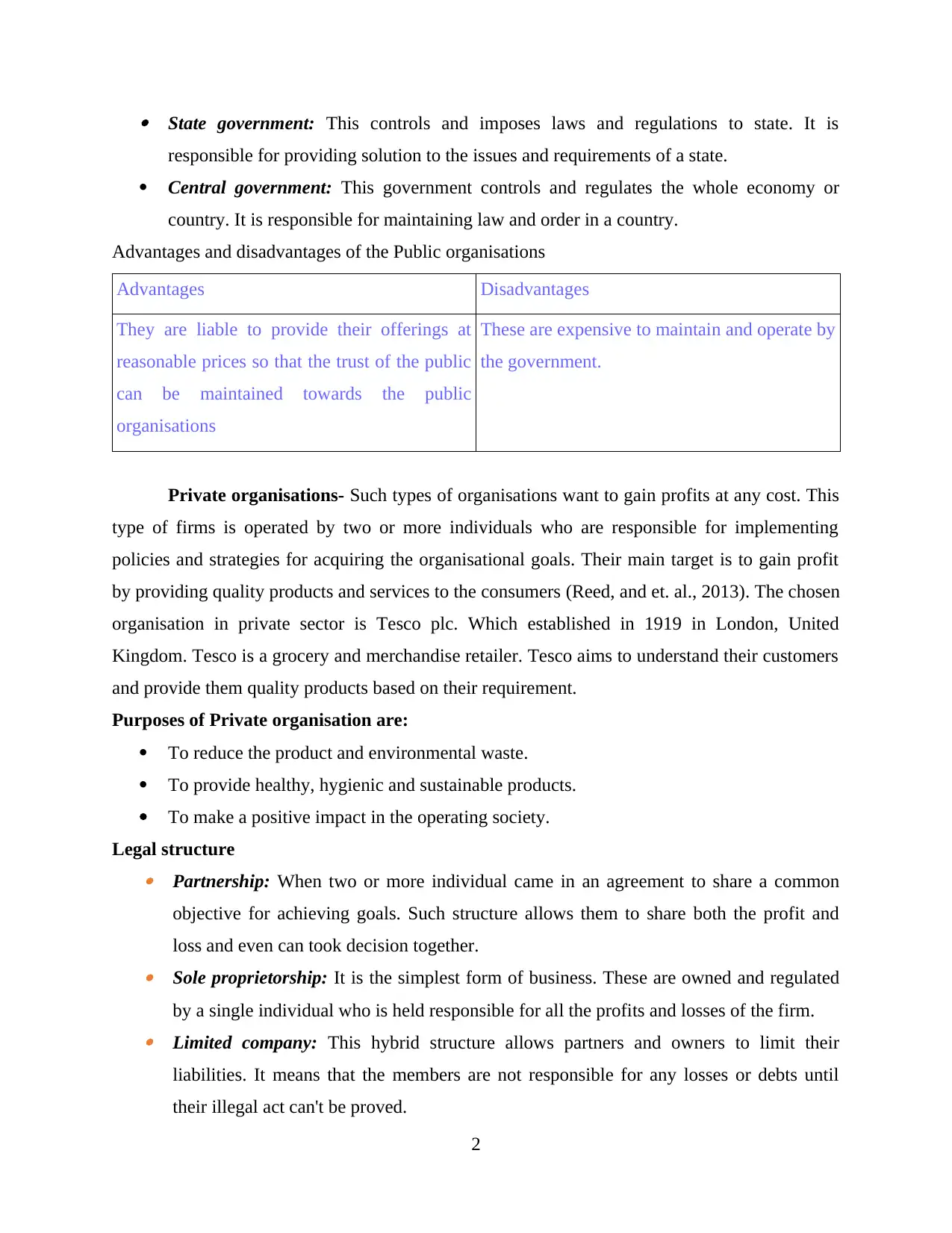
State government: This controls and imposes laws and regulations to state. It is
responsible for providing solution to the issues and requirements of a state.
Central government: This government controls and regulates the whole economy or
country. It is responsible for maintaining law and order in a country.
Advantages and disadvantages of the Public organisations
Advantages Disadvantages
They are liable to provide their offerings at
reasonable prices so that the trust of the public
can be maintained towards the public
organisations
These are expensive to maintain and operate by
the government.
Private organisations- Such types of organisations want to gain profits at any cost. This
type of firms is operated by two or more individuals who are responsible for implementing
policies and strategies for acquiring the organisational goals. Their main target is to gain profit
by providing quality products and services to the consumers (Reed, and et. al., 2013). The chosen
organisation in private sector is Tesco plc. Which established in 1919 in London, United
Kingdom. Tesco is a grocery and merchandise retailer. Tesco aims to understand their customers
and provide them quality products based on their requirement.
Purposes of Private organisation are:
To reduce the product and environmental waste.
To provide healthy, hygienic and sustainable products.
To make a positive impact in the operating society.
Legal structure Partnership: When two or more individual came in an agreement to share a common
objective for achieving goals. Such structure allows them to share both the profit and
loss and even can took decision together. Sole proprietorship: It is the simplest form of business. These are owned and regulated
by a single individual who is held responsible for all the profits and losses of the firm. Limited company: This hybrid structure allows partners and owners to limit their
liabilities. It means that the members are not responsible for any losses or debts until
their illegal act can't be proved.
2
responsible for providing solution to the issues and requirements of a state.
Central government: This government controls and regulates the whole economy or
country. It is responsible for maintaining law and order in a country.
Advantages and disadvantages of the Public organisations
Advantages Disadvantages
They are liable to provide their offerings at
reasonable prices so that the trust of the public
can be maintained towards the public
organisations
These are expensive to maintain and operate by
the government.
Private organisations- Such types of organisations want to gain profits at any cost. This
type of firms is operated by two or more individuals who are responsible for implementing
policies and strategies for acquiring the organisational goals. Their main target is to gain profit
by providing quality products and services to the consumers (Reed, and et. al., 2013). The chosen
organisation in private sector is Tesco plc. Which established in 1919 in London, United
Kingdom. Tesco is a grocery and merchandise retailer. Tesco aims to understand their customers
and provide them quality products based on their requirement.
Purposes of Private organisation are:
To reduce the product and environmental waste.
To provide healthy, hygienic and sustainable products.
To make a positive impact in the operating society.
Legal structure Partnership: When two or more individual came in an agreement to share a common
objective for achieving goals. Such structure allows them to share both the profit and
loss and even can took decision together. Sole proprietorship: It is the simplest form of business. These are owned and regulated
by a single individual who is held responsible for all the profits and losses of the firm. Limited company: This hybrid structure allows partners and owners to limit their
liabilities. It means that the members are not responsible for any losses or debts until
their illegal act can't be proved.
2
Paraphrase This Document
Need a fresh take? Get an instant paraphrase of this document with our AI Paraphraser
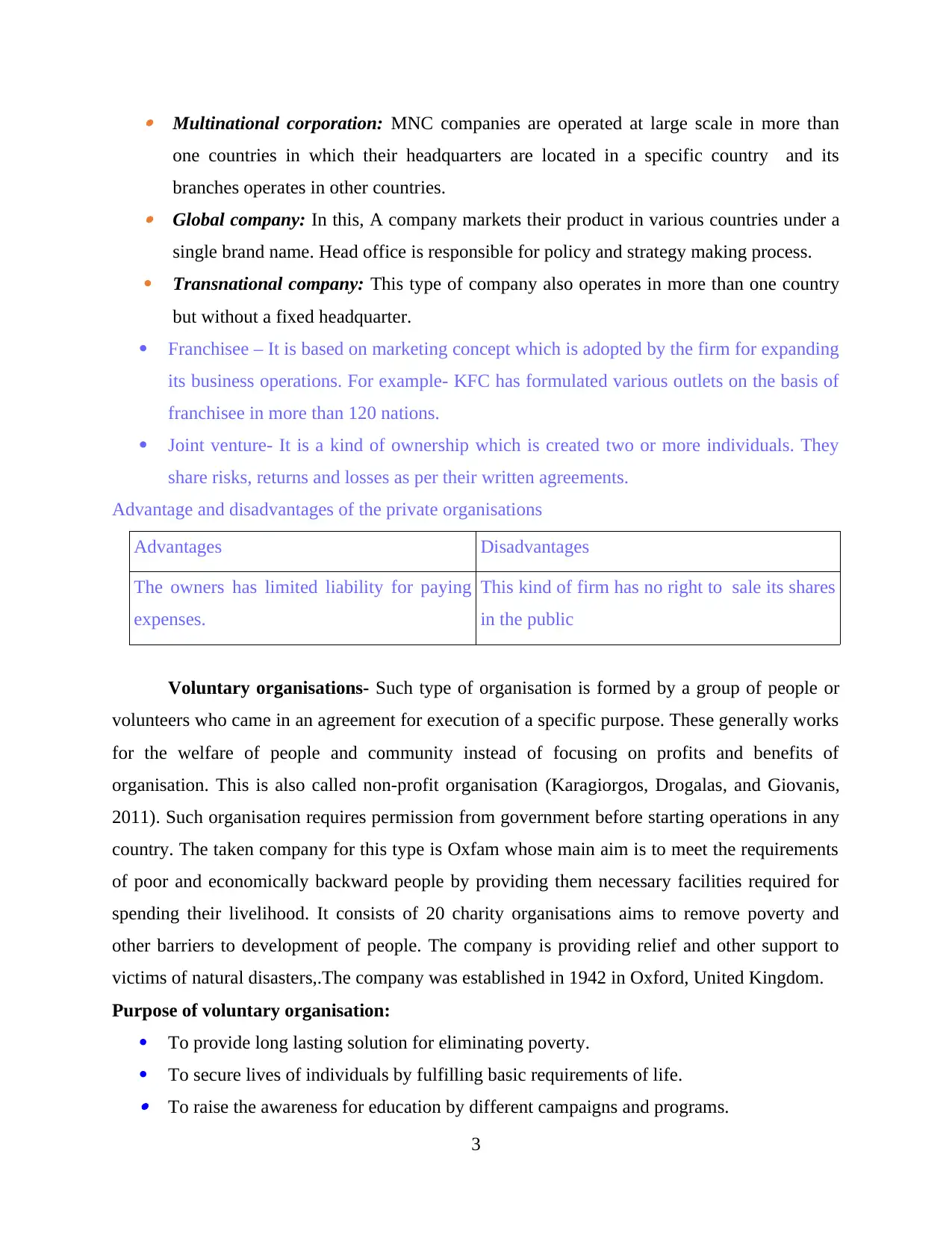
Multinational corporation: MNC companies are operated at large scale in more than
one countries in which their headquarters are located in a specific country and its
branches operates in other countries. Global company: In this, A company markets their product in various countries under a
single brand name. Head office is responsible for policy and strategy making process.
Transnational company: This type of company also operates in more than one country
but without a fixed headquarter.
Franchisee – It is based on marketing concept which is adopted by the firm for expanding
its business operations. For example- KFC has formulated various outlets on the basis of
franchisee in more than 120 nations.
Joint venture- It is a kind of ownership which is created two or more individuals. They
share risks, returns and losses as per their written agreements.
Advantage and disadvantages of the private organisations
Advantages Disadvantages
The owners has limited liability for paying
expenses.
This kind of firm has no right to sale its shares
in the public
Voluntary organisations- Such type of organisation is formed by a group of people or
volunteers who came in an agreement for execution of a specific purpose. These generally works
for the welfare of people and community instead of focusing on profits and benefits of
organisation. This is also called non-profit organisation (Karagiorgos, Drogalas, and Giovanis,
2011). Such organisation requires permission from government before starting operations in any
country. The taken company for this type is Oxfam whose main aim is to meet the requirements
of poor and economically backward people by providing them necessary facilities required for
spending their livelihood. It consists of 20 charity organisations aims to remove poverty and
other barriers to development of people. The company is providing relief and other support to
victims of natural disasters,.The company was established in 1942 in Oxford, United Kingdom.
Purpose of voluntary organisation:
To provide long lasting solution for eliminating poverty.
To secure lives of individuals by fulfilling basic requirements of life. To raise the awareness for education by different campaigns and programs.
3
one countries in which their headquarters are located in a specific country and its
branches operates in other countries. Global company: In this, A company markets their product in various countries under a
single brand name. Head office is responsible for policy and strategy making process.
Transnational company: This type of company also operates in more than one country
but without a fixed headquarter.
Franchisee – It is based on marketing concept which is adopted by the firm for expanding
its business operations. For example- KFC has formulated various outlets on the basis of
franchisee in more than 120 nations.
Joint venture- It is a kind of ownership which is created two or more individuals. They
share risks, returns and losses as per their written agreements.
Advantage and disadvantages of the private organisations
Advantages Disadvantages
The owners has limited liability for paying
expenses.
This kind of firm has no right to sale its shares
in the public
Voluntary organisations- Such type of organisation is formed by a group of people or
volunteers who came in an agreement for execution of a specific purpose. These generally works
for the welfare of people and community instead of focusing on profits and benefits of
organisation. This is also called non-profit organisation (Karagiorgos, Drogalas, and Giovanis,
2011). Such organisation requires permission from government before starting operations in any
country. The taken company for this type is Oxfam whose main aim is to meet the requirements
of poor and economically backward people by providing them necessary facilities required for
spending their livelihood. It consists of 20 charity organisations aims to remove poverty and
other barriers to development of people. The company is providing relief and other support to
victims of natural disasters,.The company was established in 1942 in Oxford, United Kingdom.
Purpose of voluntary organisation:
To provide long lasting solution for eliminating poverty.
To secure lives of individuals by fulfilling basic requirements of life. To raise the awareness for education by different campaigns and programs.
3
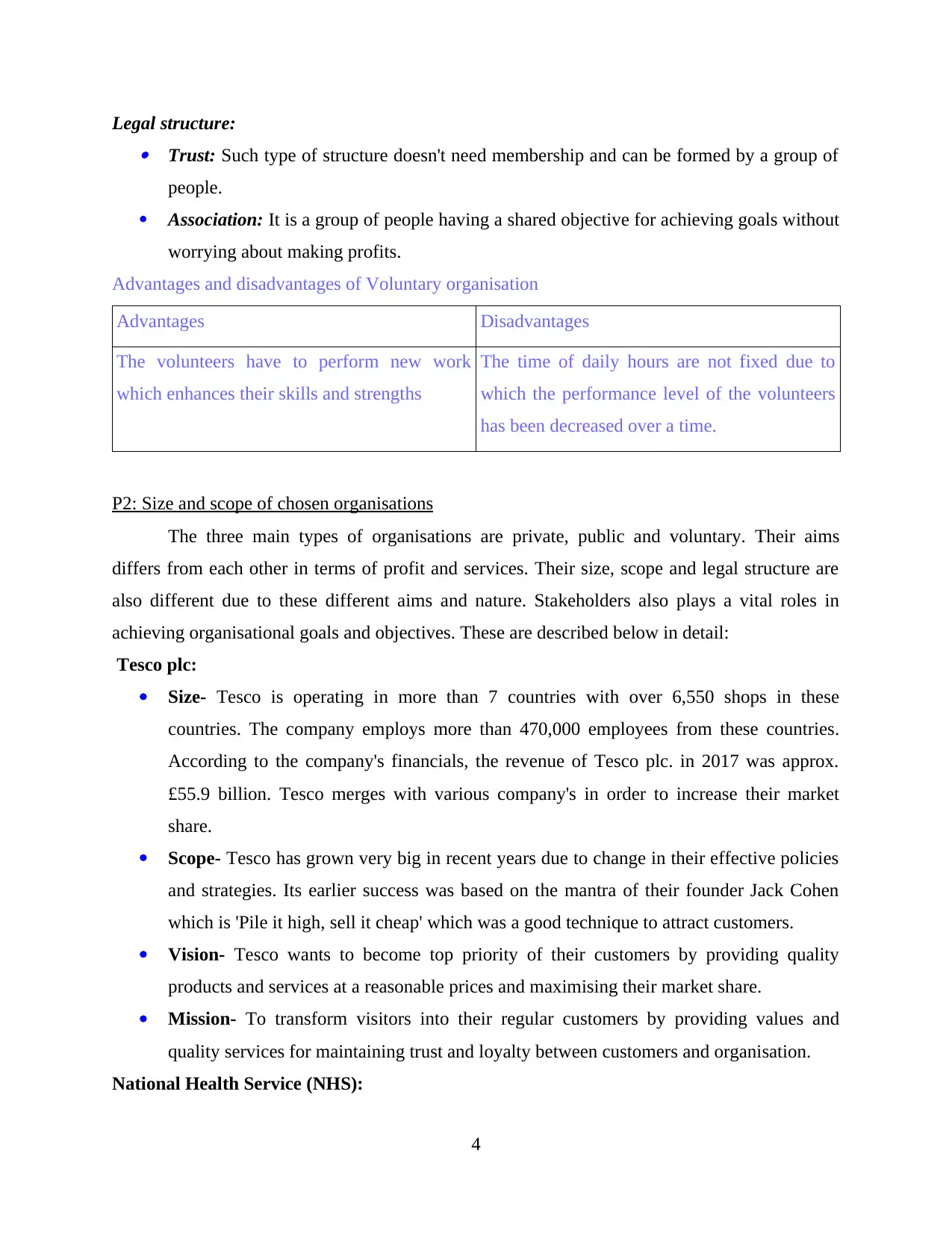
Legal structure: Trust: Such type of structure doesn't need membership and can be formed by a group of
people.
Association: It is a group of people having a shared objective for achieving goals without
worrying about making profits.
Advantages and disadvantages of Voluntary organisation
Advantages Disadvantages
The volunteers have to perform new work
which enhances their skills and strengths
The time of daily hours are not fixed due to
which the performance level of the volunteers
has been decreased over a time.
P2: Size and scope of chosen organisations
The three main types of organisations are private, public and voluntary. Their aims
differs from each other in terms of profit and services. Their size, scope and legal structure are
also different due to these different aims and nature. Stakeholders also plays a vital roles in
achieving organisational goals and objectives. These are described below in detail:
Tesco plc:
Size- Tesco is operating in more than 7 countries with over 6,550 shops in these
countries. The company employs more than 470,000 employees from these countries.
According to the company's financials, the revenue of Tesco plc. in 2017 was approx.
£55.9 billion. Tesco merges with various company's in order to increase their market
share.
Scope- Tesco has grown very big in recent years due to change in their effective policies
and strategies. Its earlier success was based on the mantra of their founder Jack Cohen
which is 'Pile it high, sell it cheap' which was a good technique to attract customers.
Vision- Tesco wants to become top priority of their customers by providing quality
products and services at a reasonable prices and maximising their market share.
Mission- To transform visitors into their regular customers by providing values and
quality services for maintaining trust and loyalty between customers and organisation.
National Health Service (NHS):
4
people.
Association: It is a group of people having a shared objective for achieving goals without
worrying about making profits.
Advantages and disadvantages of Voluntary organisation
Advantages Disadvantages
The volunteers have to perform new work
which enhances their skills and strengths
The time of daily hours are not fixed due to
which the performance level of the volunteers
has been decreased over a time.
P2: Size and scope of chosen organisations
The three main types of organisations are private, public and voluntary. Their aims
differs from each other in terms of profit and services. Their size, scope and legal structure are
also different due to these different aims and nature. Stakeholders also plays a vital roles in
achieving organisational goals and objectives. These are described below in detail:
Tesco plc:
Size- Tesco is operating in more than 7 countries with over 6,550 shops in these
countries. The company employs more than 470,000 employees from these countries.
According to the company's financials, the revenue of Tesco plc. in 2017 was approx.
£55.9 billion. Tesco merges with various company's in order to increase their market
share.
Scope- Tesco has grown very big in recent years due to change in their effective policies
and strategies. Its earlier success was based on the mantra of their founder Jack Cohen
which is 'Pile it high, sell it cheap' which was a good technique to attract customers.
Vision- Tesco wants to become top priority of their customers by providing quality
products and services at a reasonable prices and maximising their market share.
Mission- To transform visitors into their regular customers by providing values and
quality services for maintaining trust and loyalty between customers and organisation.
National Health Service (NHS):
4
⊘ This is a preview!⊘
Do you want full access?
Subscribe today to unlock all pages.

Trusted by 1+ million students worldwide
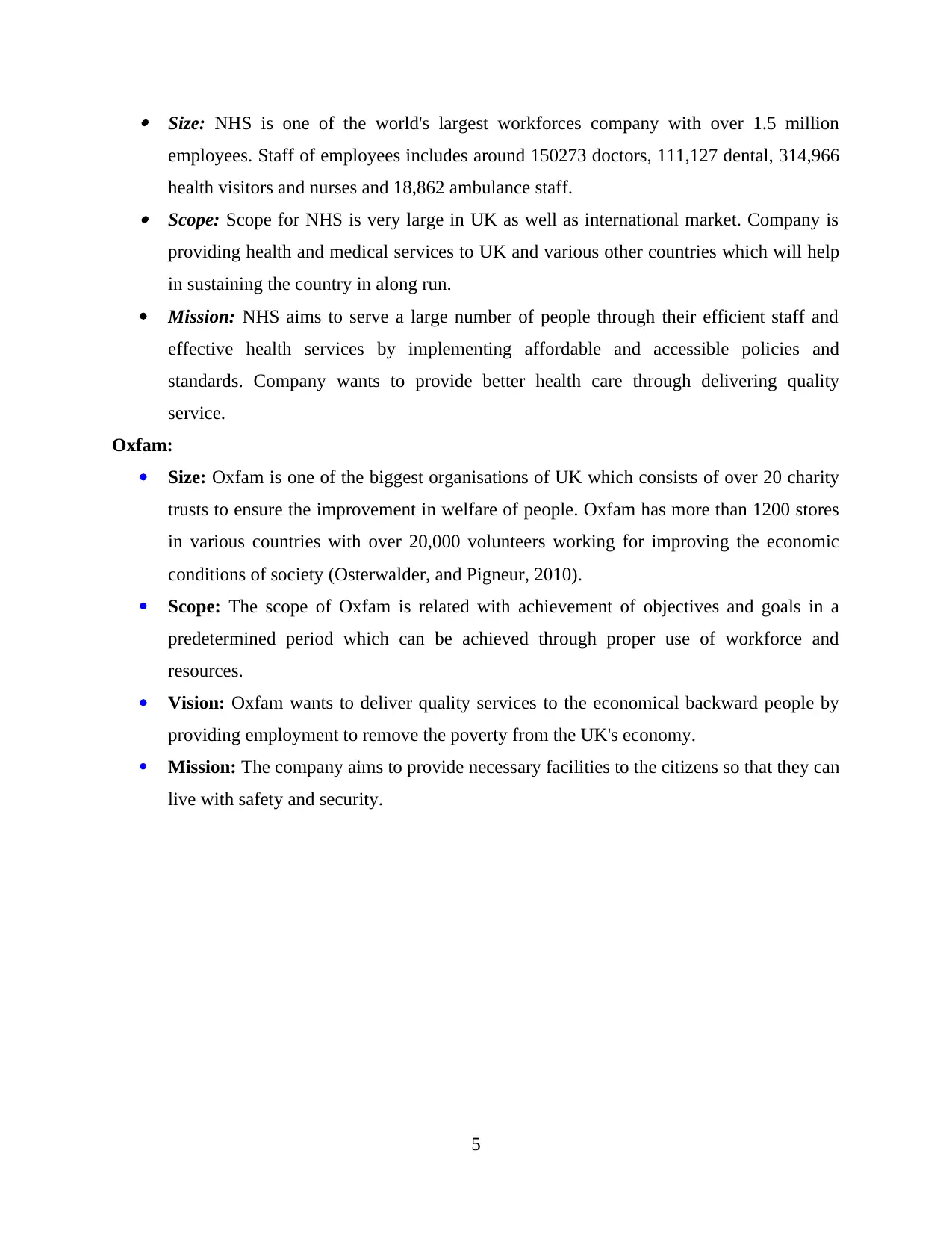
Size: NHS is one of the world's largest workforces company with over 1.5 million
employees. Staff of employees includes around 150273 doctors, 111,127 dental, 314,966
health visitors and nurses and 18,862 ambulance staff. Scope: Scope for NHS is very large in UK as well as international market. Company is
providing health and medical services to UK and various other countries which will help
in sustaining the country in along run.
Mission: NHS aims to serve a large number of people through their efficient staff and
effective health services by implementing affordable and accessible policies and
standards. Company wants to provide better health care through delivering quality
service.
Oxfam:
Size: Oxfam is one of the biggest organisations of UK which consists of over 20 charity
trusts to ensure the improvement in welfare of people. Oxfam has more than 1200 stores
in various countries with over 20,000 volunteers working for improving the economic
conditions of society (Osterwalder, and Pigneur, 2010).
Scope: The scope of Oxfam is related with achievement of objectives and goals in a
predetermined period which can be achieved through proper use of workforce and
resources.
Vision: Oxfam wants to deliver quality services to the economical backward people by
providing employment to remove the poverty from the UK's economy.
Mission: The company aims to provide necessary facilities to the citizens so that they can
live with safety and security.
5
employees. Staff of employees includes around 150273 doctors, 111,127 dental, 314,966
health visitors and nurses and 18,862 ambulance staff. Scope: Scope for NHS is very large in UK as well as international market. Company is
providing health and medical services to UK and various other countries which will help
in sustaining the country in along run.
Mission: NHS aims to serve a large number of people through their efficient staff and
effective health services by implementing affordable and accessible policies and
standards. Company wants to provide better health care through delivering quality
service.
Oxfam:
Size: Oxfam is one of the biggest organisations of UK which consists of over 20 charity
trusts to ensure the improvement in welfare of people. Oxfam has more than 1200 stores
in various countries with over 20,000 volunteers working for improving the economic
conditions of society (Osterwalder, and Pigneur, 2010).
Scope: The scope of Oxfam is related with achievement of objectives and goals in a
predetermined period which can be achieved through proper use of workforce and
resources.
Vision: Oxfam wants to deliver quality services to the economical backward people by
providing employment to remove the poverty from the UK's economy.
Mission: The company aims to provide necessary facilities to the citizens so that they can
live with safety and security.
5
Paraphrase This Document
Need a fresh take? Get an instant paraphrase of this document with our AI Paraphraser
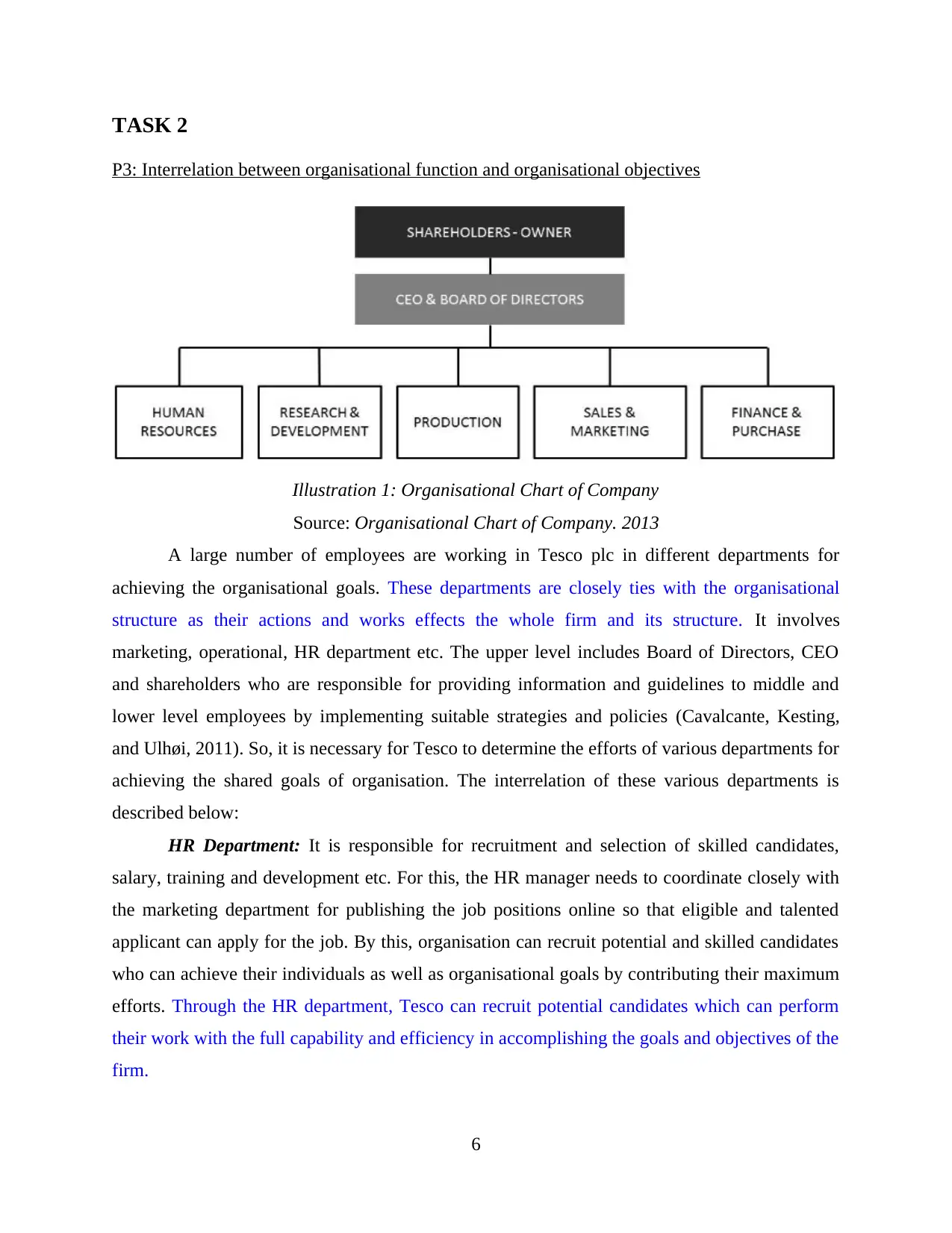
TASK 2
P3: Interrelation between organisational function and organisational objectives
Illustration 1: Organisational Chart of Company
Source: Organisational Chart of Company. 2013
A large number of employees are working in Tesco plc in different departments for
achieving the organisational goals. These departments are closely ties with the organisational
structure as their actions and works effects the whole firm and its structure. It involves
marketing, operational, HR department etc. The upper level includes Board of Directors, CEO
and shareholders who are responsible for providing information and guidelines to middle and
lower level employees by implementing suitable strategies and policies (Cavalcante, Kesting,
and Ulhøi, 2011). So, it is necessary for Tesco to determine the efforts of various departments for
achieving the shared goals of organisation. The interrelation of these various departments is
described below:
HR Department: It is responsible for recruitment and selection of skilled candidates,
salary, training and development etc. For this, the HR manager needs to coordinate closely with
the marketing department for publishing the job positions online so that eligible and talented
applicant can apply for the job. By this, organisation can recruit potential and skilled candidates
who can achieve their individuals as well as organisational goals by contributing their maximum
efforts. Through the HR department, Tesco can recruit potential candidates which can perform
their work with the full capability and efficiency in accomplishing the goals and objectives of the
firm.
6
P3: Interrelation between organisational function and organisational objectives
Illustration 1: Organisational Chart of Company
Source: Organisational Chart of Company. 2013
A large number of employees are working in Tesco plc in different departments for
achieving the organisational goals. These departments are closely ties with the organisational
structure as their actions and works effects the whole firm and its structure. It involves
marketing, operational, HR department etc. The upper level includes Board of Directors, CEO
and shareholders who are responsible for providing information and guidelines to middle and
lower level employees by implementing suitable strategies and policies (Cavalcante, Kesting,
and Ulhøi, 2011). So, it is necessary for Tesco to determine the efforts of various departments for
achieving the shared goals of organisation. The interrelation of these various departments is
described below:
HR Department: It is responsible for recruitment and selection of skilled candidates,
salary, training and development etc. For this, the HR manager needs to coordinate closely with
the marketing department for publishing the job positions online so that eligible and talented
applicant can apply for the job. By this, organisation can recruit potential and skilled candidates
who can achieve their individuals as well as organisational goals by contributing their maximum
efforts. Through the HR department, Tesco can recruit potential candidates which can perform
their work with the full capability and efficiency in accomplishing the goals and objectives of the
firm.
6
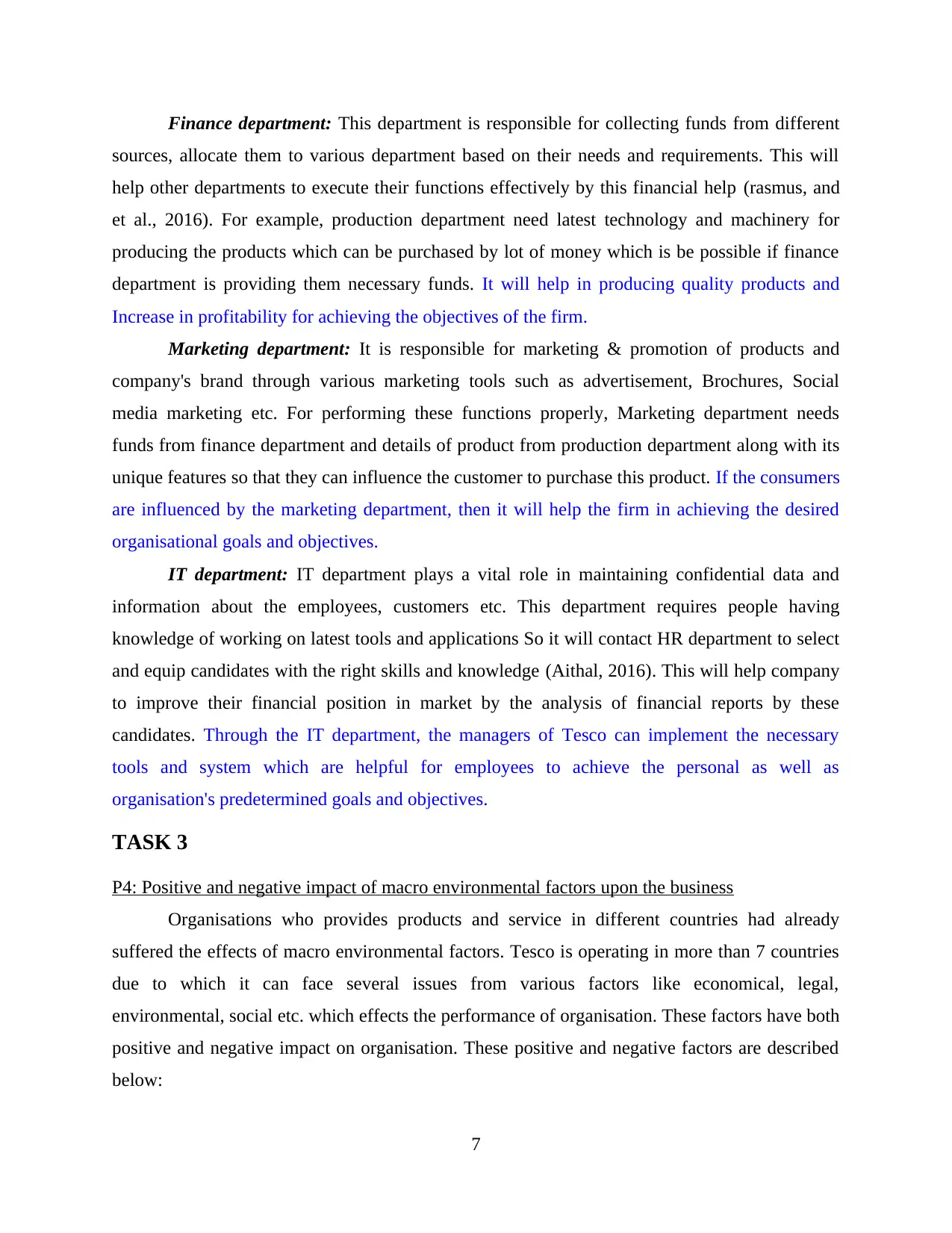
Finance department: This department is responsible for collecting funds from different
sources, allocate them to various department based on their needs and requirements. This will
help other departments to execute their functions effectively by this financial help (rasmus, and
et al., 2016). For example, production department need latest technology and machinery for
producing the products which can be purchased by lot of money which is be possible if finance
department is providing them necessary funds. It will help in producing quality products and
Increase in profitability for achieving the objectives of the firm.
Marketing department: It is responsible for marketing & promotion of products and
company's brand through various marketing tools such as advertisement, Brochures, Social
media marketing etc. For performing these functions properly, Marketing department needs
funds from finance department and details of product from production department along with its
unique features so that they can influence the customer to purchase this product. If the consumers
are influenced by the marketing department, then it will help the firm in achieving the desired
organisational goals and objectives.
IT department: IT department plays a vital role in maintaining confidential data and
information about the employees, customers etc. This department requires people having
knowledge of working on latest tools and applications So it will contact HR department to select
and equip candidates with the right skills and knowledge (Aithal, 2016). This will help company
to improve their financial position in market by the analysis of financial reports by these
candidates. Through the IT department, the managers of Tesco can implement the necessary
tools and system which are helpful for employees to achieve the personal as well as
organisation's predetermined goals and objectives.
TASK 3
P4: Positive and negative impact of macro environmental factors upon the business
Organisations who provides products and service in different countries had already
suffered the effects of macro environmental factors. Tesco is operating in more than 7 countries
due to which it can face several issues from various factors like economical, legal,
environmental, social etc. which effects the performance of organisation. These factors have both
positive and negative impact on organisation. These positive and negative factors are described
below:
7
sources, allocate them to various department based on their needs and requirements. This will
help other departments to execute their functions effectively by this financial help (rasmus, and
et al., 2016). For example, production department need latest technology and machinery for
producing the products which can be purchased by lot of money which is be possible if finance
department is providing them necessary funds. It will help in producing quality products and
Increase in profitability for achieving the objectives of the firm.
Marketing department: It is responsible for marketing & promotion of products and
company's brand through various marketing tools such as advertisement, Brochures, Social
media marketing etc. For performing these functions properly, Marketing department needs
funds from finance department and details of product from production department along with its
unique features so that they can influence the customer to purchase this product. If the consumers
are influenced by the marketing department, then it will help the firm in achieving the desired
organisational goals and objectives.
IT department: IT department plays a vital role in maintaining confidential data and
information about the employees, customers etc. This department requires people having
knowledge of working on latest tools and applications So it will contact HR department to select
and equip candidates with the right skills and knowledge (Aithal, 2016). This will help company
to improve their financial position in market by the analysis of financial reports by these
candidates. Through the IT department, the managers of Tesco can implement the necessary
tools and system which are helpful for employees to achieve the personal as well as
organisation's predetermined goals and objectives.
TASK 3
P4: Positive and negative impact of macro environmental factors upon the business
Organisations who provides products and service in different countries had already
suffered the effects of macro environmental factors. Tesco is operating in more than 7 countries
due to which it can face several issues from various factors like economical, legal,
environmental, social etc. which effects the performance of organisation. These factors have both
positive and negative impact on organisation. These positive and negative factors are described
below:
7
⊘ This is a preview!⊘
Do you want full access?
Subscribe today to unlock all pages.

Trusted by 1+ million students worldwide
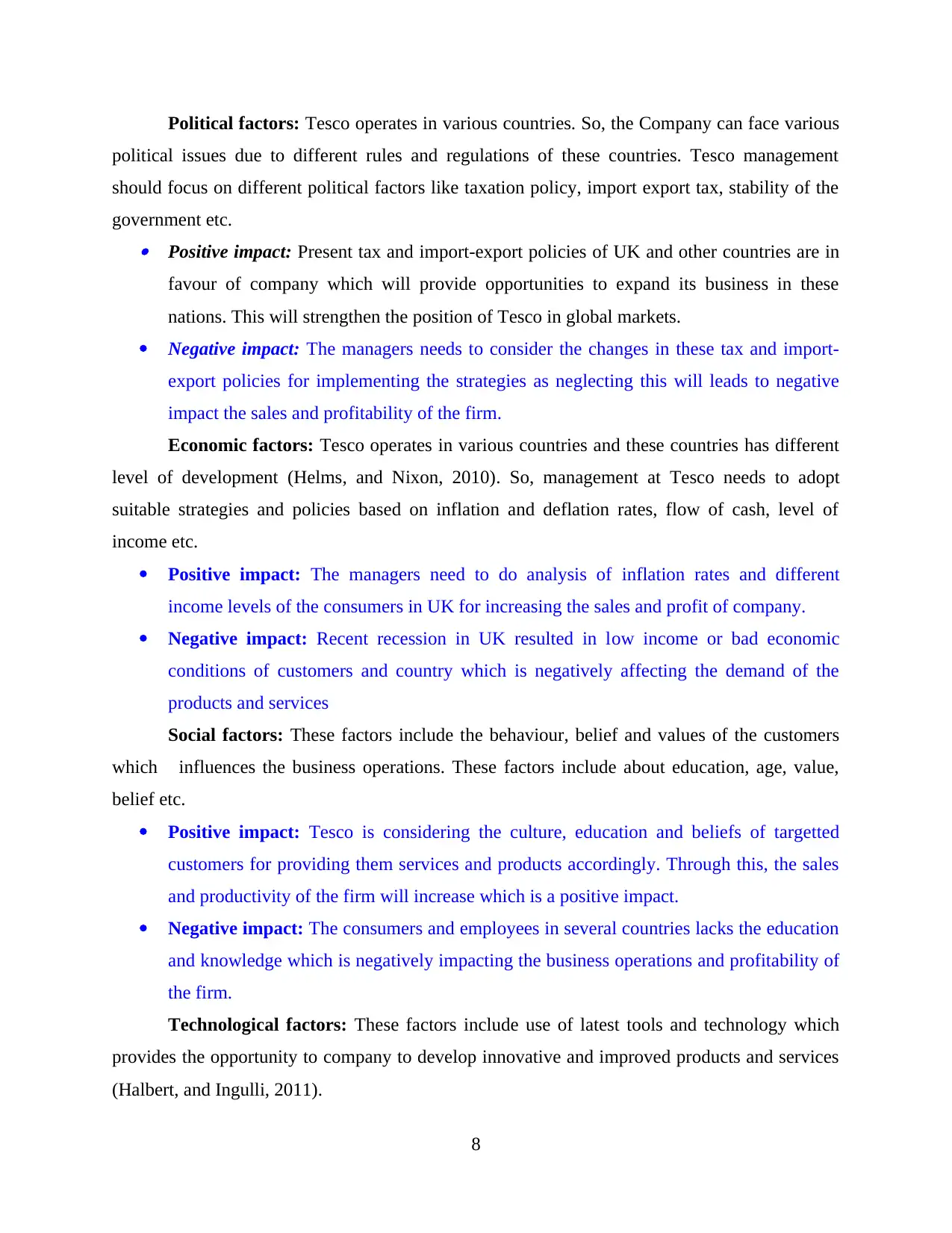
Political factors: Tesco operates in various countries. So, the Company can face various
political issues due to different rules and regulations of these countries. Tesco management
should focus on different political factors like taxation policy, import export tax, stability of the
government etc. Positive impact: Present tax and import-export policies of UK and other countries are in
favour of company which will provide opportunities to expand its business in these
nations. This will strengthen the position of Tesco in global markets.
Negative impact: The managers needs to consider the changes in these tax and import-
export policies for implementing the strategies as neglecting this will leads to negative
impact the sales and profitability of the firm.
Economic factors: Tesco operates in various countries and these countries has different
level of development (Helms, and Nixon, 2010). So, management at Tesco needs to adopt
suitable strategies and policies based on inflation and deflation rates, flow of cash, level of
income etc.
Positive impact: The managers need to do analysis of inflation rates and different
income levels of the consumers in UK for increasing the sales and profit of company.
Negative impact: Recent recession in UK resulted in low income or bad economic
conditions of customers and country which is negatively affecting the demand of the
products and services
Social factors: These factors include the behaviour, belief and values of the customers
which influences the business operations. These factors include about education, age, value,
belief etc.
Positive impact: Tesco is considering the culture, education and beliefs of targetted
customers for providing them services and products accordingly. Through this, the sales
and productivity of the firm will increase which is a positive impact.
Negative impact: The consumers and employees in several countries lacks the education
and knowledge which is negatively impacting the business operations and profitability of
the firm.
Technological factors: These factors include use of latest tools and technology which
provides the opportunity to company to develop innovative and improved products and services
(Halbert, and Ingulli, 2011).
8
political issues due to different rules and regulations of these countries. Tesco management
should focus on different political factors like taxation policy, import export tax, stability of the
government etc. Positive impact: Present tax and import-export policies of UK and other countries are in
favour of company which will provide opportunities to expand its business in these
nations. This will strengthen the position of Tesco in global markets.
Negative impact: The managers needs to consider the changes in these tax and import-
export policies for implementing the strategies as neglecting this will leads to negative
impact the sales and profitability of the firm.
Economic factors: Tesco operates in various countries and these countries has different
level of development (Helms, and Nixon, 2010). So, management at Tesco needs to adopt
suitable strategies and policies based on inflation and deflation rates, flow of cash, level of
income etc.
Positive impact: The managers need to do analysis of inflation rates and different
income levels of the consumers in UK for increasing the sales and profit of company.
Negative impact: Recent recession in UK resulted in low income or bad economic
conditions of customers and country which is negatively affecting the demand of the
products and services
Social factors: These factors include the behaviour, belief and values of the customers
which influences the business operations. These factors include about education, age, value,
belief etc.
Positive impact: Tesco is considering the culture, education and beliefs of targetted
customers for providing them services and products accordingly. Through this, the sales
and productivity of the firm will increase which is a positive impact.
Negative impact: The consumers and employees in several countries lacks the education
and knowledge which is negatively impacting the business operations and profitability of
the firm.
Technological factors: These factors include use of latest tools and technology which
provides the opportunity to company to develop innovative and improved products and services
(Halbert, and Ingulli, 2011).
8
Paraphrase This Document
Need a fresh take? Get an instant paraphrase of this document with our AI Paraphraser
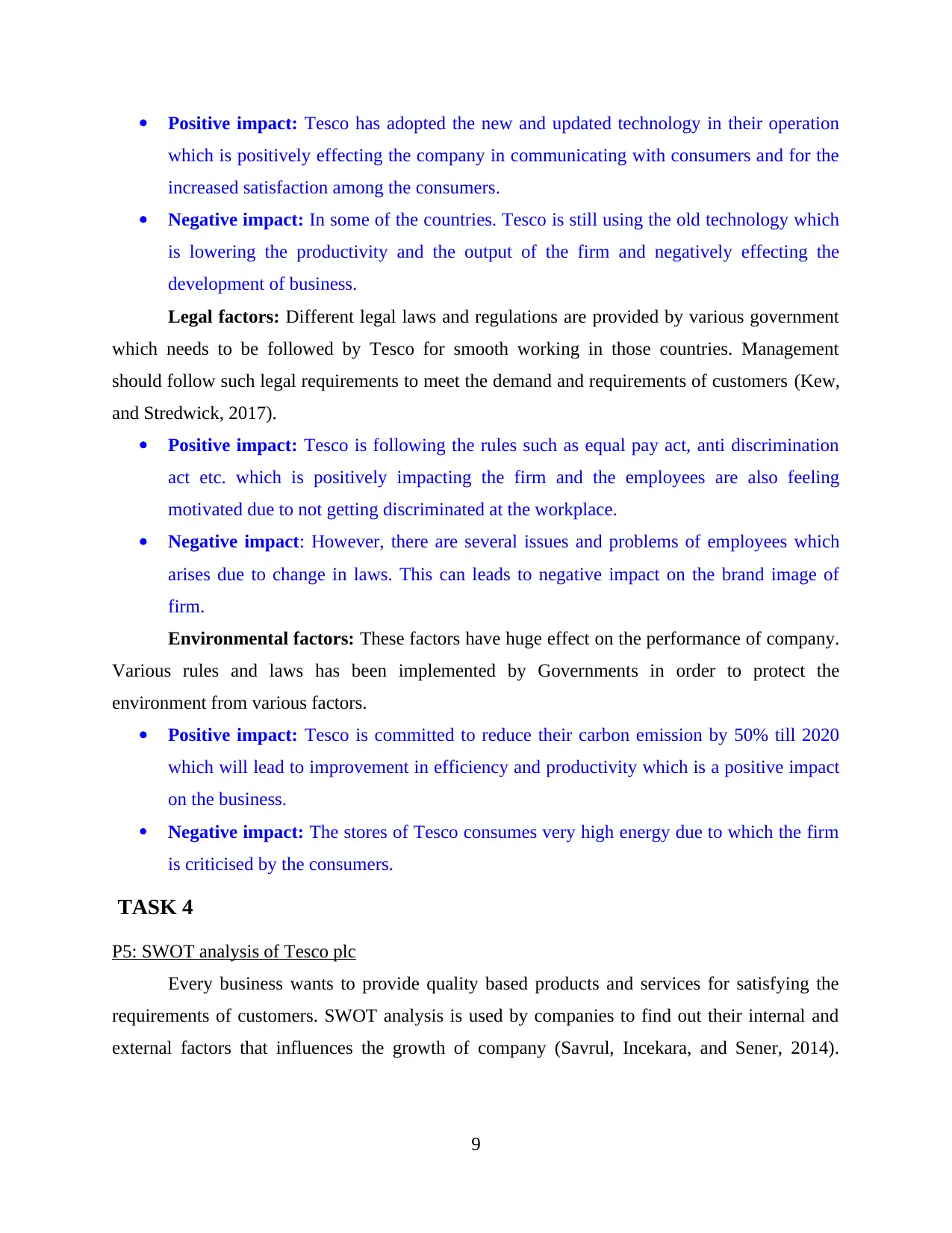
Positive impact: Tesco has adopted the new and updated technology in their operation
which is positively effecting the company in communicating with consumers and for the
increased satisfaction among the consumers.
Negative impact: In some of the countries. Tesco is still using the old technology which
is lowering the productivity and the output of the firm and negatively effecting the
development of business.
Legal factors: Different legal laws and regulations are provided by various government
which needs to be followed by Tesco for smooth working in those countries. Management
should follow such legal requirements to meet the demand and requirements of customers (Kew,
and Stredwick, 2017).
Positive impact: Tesco is following the rules such as equal pay act, anti discrimination
act etc. which is positively impacting the firm and the employees are also feeling
motivated due to not getting discriminated at the workplace.
Negative impact: However, there are several issues and problems of employees which
arises due to change in laws. This can leads to negative impact on the brand image of
firm.
Environmental factors: These factors have huge effect on the performance of company.
Various rules and laws has been implemented by Governments in order to protect the
environment from various factors.
Positive impact: Tesco is committed to reduce their carbon emission by 50% till 2020
which will lead to improvement in efficiency and productivity which is a positive impact
on the business.
Negative impact: The stores of Tesco consumes very high energy due to which the firm
is criticised by the consumers.
TASK 4
P5: SWOT analysis of Tesco plc
Every business wants to provide quality based products and services for satisfying the
requirements of customers. SWOT analysis is used by companies to find out their internal and
external factors that influences the growth of company (Savrul, Incekara, and Sener, 2014).
9
which is positively effecting the company in communicating with consumers and for the
increased satisfaction among the consumers.
Negative impact: In some of the countries. Tesco is still using the old technology which
is lowering the productivity and the output of the firm and negatively effecting the
development of business.
Legal factors: Different legal laws and regulations are provided by various government
which needs to be followed by Tesco for smooth working in those countries. Management
should follow such legal requirements to meet the demand and requirements of customers (Kew,
and Stredwick, 2017).
Positive impact: Tesco is following the rules such as equal pay act, anti discrimination
act etc. which is positively impacting the firm and the employees are also feeling
motivated due to not getting discriminated at the workplace.
Negative impact: However, there are several issues and problems of employees which
arises due to change in laws. This can leads to negative impact on the brand image of
firm.
Environmental factors: These factors have huge effect on the performance of company.
Various rules and laws has been implemented by Governments in order to protect the
environment from various factors.
Positive impact: Tesco is committed to reduce their carbon emission by 50% till 2020
which will lead to improvement in efficiency and productivity which is a positive impact
on the business.
Negative impact: The stores of Tesco consumes very high energy due to which the firm
is criticised by the consumers.
TASK 4
P5: SWOT analysis of Tesco plc
Every business wants to provide quality based products and services for satisfying the
requirements of customers. SWOT analysis is used by companies to find out their internal and
external factors that influences the growth of company (Savrul, Incekara, and Sener, 2014).
9
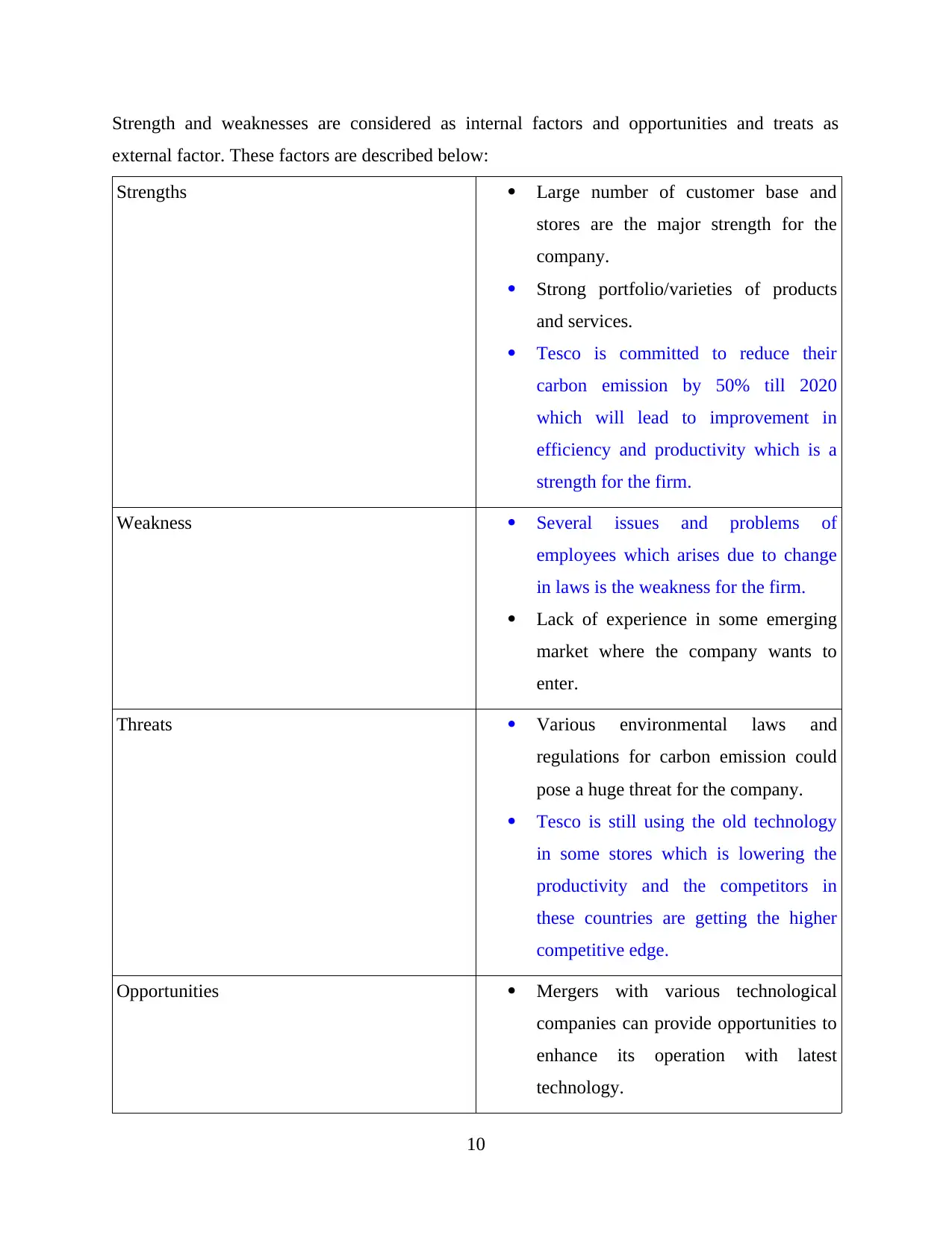
Strength and weaknesses are considered as internal factors and opportunities and treats as
external factor. These factors are described below:
Strengths Large number of customer base and
stores are the major strength for the
company.
Strong portfolio/varieties of products
and services.
Tesco is committed to reduce their
carbon emission by 50% till 2020
which will lead to improvement in
efficiency and productivity which is a
strength for the firm.
Weakness Several issues and problems of
employees which arises due to change
in laws is the weakness for the firm.
Lack of experience in some emerging
market where the company wants to
enter.
Threats Various environmental laws and
regulations for carbon emission could
pose a huge threat for the company.
Tesco is still using the old technology
in some stores which is lowering the
productivity and the competitors in
these countries are getting the higher
competitive edge.
Opportunities Mergers with various technological
companies can provide opportunities to
enhance its operation with latest
technology.
10
external factor. These factors are described below:
Strengths Large number of customer base and
stores are the major strength for the
company.
Strong portfolio/varieties of products
and services.
Tesco is committed to reduce their
carbon emission by 50% till 2020
which will lead to improvement in
efficiency and productivity which is a
strength for the firm.
Weakness Several issues and problems of
employees which arises due to change
in laws is the weakness for the firm.
Lack of experience in some emerging
market where the company wants to
enter.
Threats Various environmental laws and
regulations for carbon emission could
pose a huge threat for the company.
Tesco is still using the old technology
in some stores which is lowering the
productivity and the competitors in
these countries are getting the higher
competitive edge.
Opportunities Mergers with various technological
companies can provide opportunities to
enhance its operation with latest
technology.
10
⊘ This is a preview!⊘
Do you want full access?
Subscribe today to unlock all pages.

Trusted by 1+ million students worldwide
1 out of 15
Related Documents
Your All-in-One AI-Powered Toolkit for Academic Success.
+13062052269
info@desklib.com
Available 24*7 on WhatsApp / Email
![[object Object]](/_next/static/media/star-bottom.7253800d.svg)
Unlock your academic potential
Copyright © 2020–2025 A2Z Services. All Rights Reserved. Developed and managed by ZUCOL.




